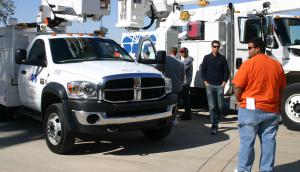AVONDALE, Arizona – The nine state pilot programs that are part of the Get Into Energy Career Pathways (GIECP) grant funded by the Bill and Melinda Gates Foundation have a not-so-secret admirer: the Arizona Energy Workforce Consortium.
The consortium, working through Estrella Mountain Community College (EMCC), launched an energy skills training program in January 2012, inspired by the GIECP pilots, but separately funded through a grant from the federal government. Using money from a State Energy Sector Partnership (SESP) grant, Estrella Mountain is able to cover tuition, books, and fees for students who will earn three energy-related credentials and up to 10 credit hours toward an Associate of Applied Science degree, either in Power Plant Technology or Radiation Protection Technology.
Clay Goodman, Vice President for Occupational Education at EMCC, said 51 students enrolled in the first cohort of EMCC’s “Get Into Energy” program will be completing in December. Recruitment for a second cohort class is currently underway with the capacity of additional funding for 15 students. Applications are due August 3, and classes begin August 18 on the EMCC campus located at Thomas and Dysart Roads in Avondale, Arizona.
The students will earn the National Career Readiness and Energy Industry Employability Skills certificates, along with the Energy Industry Fundamentals credential developed by the national Center for Energy Workforce Development (CEWD), part of the Edison Electric Institute. They will also take classes in math and personal development as they explore a wide range of energy careers and the skills needed to enter the field.
“We were able to pull the program together very quickly to take advantage of the grant opportunity and will continue to grow the program,” said Goodman.
Involvement from local utilities greatly helped with the initial recruitment process, including Salt River Project (SRP) and Arizona Public Service (APS), in particular, the Palo Verde Nuclear Generating Station, which is operated by APS. According to Goodman, the utility companies printed flyers and provided speakers for visits to local high schools, where both students and parents learned about careers in energy. The high school visits were followed up by four orientation sessions involving tours of the utilities and opportunities for students to see the heavy equipment and the environment in which they’d be working.
Educational partners include Energy Workforce Development, Maricopa Workforce Connections, and West-MEC. Their combined commitment to the community through career programs and solutions are helping to develop the recruitment pipeline and the resources for the future of this industry’s workforce.
Students also heard directly from employers that “by the time you finish one of the two-year degrees, there will be multiple jobs waiting for you,” he said. “That’s a really strong message.”
Lori Sundberg, Senior Vice President of Human Resources & Ethics at APS, said this kind of program could greatly benefit utilities as older workers retire.
“This partnership will contribute to Arizona’s economic recovery and future growth by training men and women for careers in the energy and mining industries,” she said. “Today, 23 percent of APS’ workforce is eligible for retirement, so we clearly need a pipeline of skilled workers to ensure our continued success. APS is involved in this initiative because we are all committed to working cooperatively for the good of Arizona.”
Students eligible for the program include high school juniors, seniors, returning adults and Veterans. For more information about EMCC Get Into Energy or energy-related degree programs, contact Rita Zaragoza at 623-935-8724.
